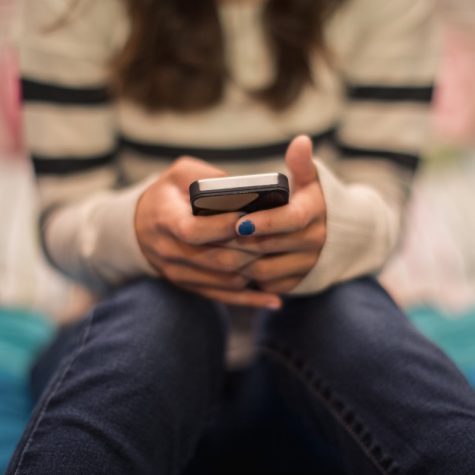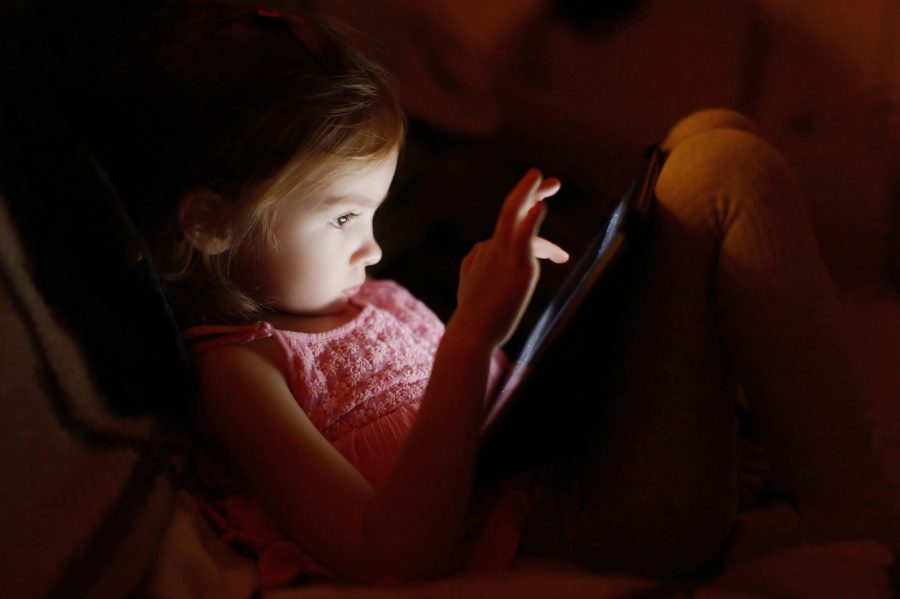Screen Time: A Rising Addiction
With cell phone use skyrocketing in popularity with the rise of social media, it’s important to evaluate its effects on students and young adults.
January 24, 2019
What’s the first thing you touch when you wake up? A number of students say their phones, with it also being the last thing that they touch before they go to sleep. Teens and preteens are entranced—sometimes for multiple hours per day—by these seemingly “harmless” devices.

All this screen time may seem innocuous, but studies conducted by researchers are showing alarming effects on young people’s physical, mental, and emotional well-being. According to CBS News, teenagers spend an average of four and a half hours a day on their phones. Additionally, according to a poll conducted on The Echo, technology seems to dominate the lives of THS students. Forty-eight percent of students stated that they spend over six hours a day looking at a screen.
My point isn’t that we should completely block out screen time, as it’s nearly impossible to go technology-free in a world that is so reliant on it. In fact, the majority of schools, including THS, are heavily reliant on computers. This necessity to use technology forces students to stare at screens. According to CNBC News, at the end of 2015, Chromebooks, the laptops that run Chrome OS—the operating system designed by Google—made up a whopping 4.4 million of the 8.9 million devices K-12 schools purchased. It can be quite difficult to completely detox yourself from screen time, as I too sit here guiltily staring for multiple hours at a Chromebook as I write this. But we can try to limit our screen time, to make ourselves aware of how much time we spend looking at a screen, and to know when too much is too much.
Apple has acknowledged the potential addictiveness of their devices and apps by adding a screen time feature that can help limit and restrict people’s screen time. The new feature, aptly named “screen time,” which was released in iOS 12, allows users to analyze the time spent on their device. For example, one can see how much time was spent on his or her device and in each individual application. With this new feature, users can also set time limits on particulars apps, and even set designated “down time.” This feature turns off all notifications except incoming calls and those that a user allows.
Studies have also shown that increased screen time has led to trouble focusing and has greatly shortened young people’s attention spans. According to Angelique O’Rourke in her article on Live Plan, increased time spent indoors hooked by a device has been linked to higher rates of ADD/ADHD. In O’Rourke’s piece, she explains more in depth how the two are connected. When we receive an Instagram notification that someone has liked our photo or when we get an alert that we have just unlocked a new level in a game, dopamine is quickly released from the brain. It’s the reward system for our brain that our bodies have set up. It works with other ideas too. When you’re hungry, you eat food, knowing you’ll feel satisfied after you eat. When you drink water after being parched—bam!— Dopamine was just released. This instantaneous reward system is the reason behind addictions. We want to feel good right away, but we don’t stop to consider the long-term effects.
Screen time has taken a toll on the mental health of our youth. U.S. News described how tech giants—Google, Snapchat, Instagram, Facebook, YouTube—are well-aware of what they’re doing. These products are designed to keep us “hooked” and “addicted.” So addicted, in fact, that it’s becoming a problem. A 2017 study in the journal Clinical Psychological Science found that adolescents who spent time on smartphones and social media were more likely to report mental health issues. However, adolescents who spent more time off technology and on other activities like religious services, social gatherings, sports, and homework were less likely to complain of mental health issues. We can’t continue to be the mentally-insecure smartphone generation adults are making us out to be, and we certainly can’t look like mummies entranced by screens.

Yet, some believe technology and the introduction of smartphones have helped us come a long way and that it has had a positive impact on us. “I feel that having technology makes things so easy,” said Olivia Wong (’20), “I don’t have to hand write flashcards when studying; I can just type them up.” Another student agreed that technology has helped us more than hurt us. “Technology is a big part of our lives today and it has helped us do so many things for school and connect with people on a daily basis,” said Liana Shtern (’20). However, while technology has its advantages, it also has its disadvantages. Jean Twenge, an American psychologist and a professor of psychology at San Diego State University, agrees that technology’s downs are outweighing its ups; that it’s reached a point where the devices are becoming too powerful. “It should be a tool that you use, not a tool that uses you,” said Twenge on a 60 Minutes segment on CBS News.
Other students agree with Twenge. “I don’t see any positive aspects,” said Emma Sindoni (’20). “There’s a lack of creativity and motivation [driven by technology]. If technology wasn’t here, I think it would push us to think harder and get more creative and unique in our thinking.”
Physically, all that screen time may be taking a huge toll on our youth. Too much screen time could potentially be altering the structure of children’s brains and impairing their vision. Sindoni said that she noticed her vision became blurry from the time that she started to increase her screen time up until today. According to the American Optometric Association, parents and caregivers should watch for signs of digital eye strain in children, which can cause burning, itchy, or tired eyes; headaches; fatigue; loss of focus; blurred vision; double vision; or head and neck pain. When it comes to protecting children’s eyes and vision, encourage them to take frequent visual breaks by practicing the 20-20-20 rule: when using technology or doing near work, take a 20-second break, every 20 minutes and view something 20 feet away. Today’s electronic devices also give off high-energy, short-wavelength, blue and violet light, which may affect vision and even prematurely age the eyes. Early research shows that overexposure to blue light could contribute to eye strain and discomfort and may lead to serious conditions in later life such as age-related macular degeneration (AMD), which can cause blindness.
According to CBS News, the federal government has, through the National Institute of Health, launched a study on adolescent brain development. The study included interviewing 9- and 10-year-old children and then ordering an M.R.I to scan their brains to discover the effects of increased screen time. They found that the brain scans of children who spent more than seven hours on smartphones, tablets, or video games were much different than those of other children in that the scans of the children who spent over seven hours per day using technology showed a premature thinning of the cortex, the wrinkly outermost layer of the brain that processes information through the five senses. However, researchers don’t know if this is being directly caused by the screen time and won’t be sure until they’ve followed the children for a longer period of time.

Mentally and emotionally speaking, the increase in time spent on screens and social media platforms has led to multiple cases of addiction, depression, anxiety, and suicidal thoughts. The 60 Minutes segment on screen time found that kids who spend more than two hours a day on screens obtained lower scores on thinking and language tests.
With the time teens and children are spending on electronic devices increasing, many essential life skills are being abandoned—social skills, social interaction, creativity, and motivation. Teenagers’ motivation and self-confidence can also be seen plummeting.
According to CBS News, E.R. visits for self-harm, like cutting, have tripled among girls age 10 to 14. In 2011, for the first time in 24 years, the teen suicide rate was higher than the teen homicide rate. Twenge said that depression could be caused by the time teens spend on phones or what they are actually doing on their phones. In a month-long experiment at the University of Pennsylvania, college students who limited themselves to just 30 minutes a day on Facebook, Instagram, and Snapchat reported significant decreases in loneliness and depression.
According to CBS News, all that time staring at screens has resulted in a fundamental shift in how a generation of American kids acts and thinks. Twenge was startled to find that the percentage of teens who reported drinking or having sex has fallen and the percentage that said they were lonely or depressed has spiked. While it is possible other factors may have played a role, Twenge said she was not able to find any other factors that correlated as closely as the growing popularity of smartphone and social media usage. According to Twenge’s piece in The Atlantic, 12th-graders in 2015 were going out less often than eighth-graders did as recently as 2009. The “Monitoring the Future” survey, funded by the National Institute on Drug Abuse and designed to be nationally representative, has asked 12th-graders more than 1,000 questions every year since 1975 and queried eighth- and 10th-grade students since 1991. Teens who spend more time than average using screens are more likely to be unhappy, and those who spend more time than average on non-screen activities are more likely to be happy. Today’s teens may go to fewer parties and spend less time together in person, but when they do congregate, they document their hangouts relentlessly on Snapchat, Instagram, Facebook. Those not invited along are keenly aware of it. Accordingly, the number of teens who feel left out has reached all-time highs across age groups. Like the increase in loneliness, the upswing in feeling left out has been swift and significant.
According to CBS News, Tristan Harris, a former Google manager who was one of the first Silicon Valley insiders to publicly acknowledge that phones and apps are being designed to capture and keep kids’ attention, screens are “engaging by design. There’s a whole playbook of techniques that get used to get you using the product for as long as possible,” said Harris. “This is about the war for attention and where that’s taking society and technology.”


















































































































































